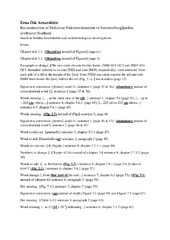Blar i tittel Institutt for geovitenskap
Viser treff 708-727 av 982
-
Rapid Atlantification along the Fram Strait at the beginning of the 20th century
(Journal article; Tidsskriftartikkel; Peer reviewed, 2021-11-24)The recent expansion of Atlantic waters into the Arctic Ocean represents undisputable evidence of the rapid changes occurring in this region. Understanding the past variability of this “Atlantification” is thus crucial in providing a longer perspective on the modern Arctic changes. Here, we reconstruct the history of Atlantification along the eastern Fram Strait during the past 800 years using ... -
Rapid post-glacial bedrock weathering in coastal Norway
(Journal article; Tidsskriftartikkel; Peer reviewed, 2021-10-26)Quantifying bedrock weathering rates under diverse climate conditions is essential to understanding timescales of landscape evolution. Yet, weathering rates are often difficult to constrain, and associating a weathered landform to a specific formative environment can be complicated by overprinting of successive processes and temporally varying climate. In this study, we investigate three sites ... -
Rapid Surface Lowering of Benito Glacier, Northern Patagonian Icefield
(Journal article; Tidsskriftartikkel; Peer reviewed, 2018-05-01)The Patagonian Icefields, which straddle the Andes below 46°S, are two of the most sensitive ice masses on Earth to climate change. However, recent mass loss from the icefields along with its spatial and temporal variability is not well-constrained. Here we determine surface elevation changes of Benito Glacier, a 163 km2 outlet glacier draining the western flank of the North Patagonian Icefield, ... -
Rapid temperature rise may have triggered glacier surges all over Svalbard
(Mastergradsoppgave; Master thesis, 2020-05-04)Observational and geomorphological records suggest that most glaciers on Svalbard reached their maximum Little Ice Age extents by means of surging. Furthermore, it seems to have happened within just a few decades, suggesting that the rapid concurrent changes in climate might have triggered this widespread surging. The specific precipitation and temperature range of Svalbard seems optimal for glacier ... -
The Raunis section, central Latvia, revisited: first luminescence results and re-evaluation of a key Baltic States stratigraphic site
(Journal article; Tidsskriftartikkel; Peer reviewed, 2020-09-08)In interstadial deposits, sand interbeds gain limited consideration in comparison with organic sediments, and therefore tend to be underrepresented in paleoenvironmental reconstructions. The Raunis site, central-eastern Latvia, is an example where organic beds have already gained some attention and been used to understand the complex interactions between advance and retreat of the Scandinavian Ice ... -
Re-evaluation and extension of the Marine Isotope Stage 5 tephrostratigraphy of the Faroe Islands region: The cryptotephra record
(Journal article; Tidsskriftartikkel; Peer reviewed, 2014) -
Recent acceleration of a rock glacier complex, Ádjet, Norway, documented by 62 years of remote sensing observations
(Journal article; Tidsskriftartikkel; Peer reviewed, 2018-08-23)Recent acceleration of rock glaciers is well recognized in the European Alps, but similar behavior is hardly documented elsewhere. Also, the controlling factors are not fully understood. Here we provide evidence for acceleration of a rock glacier complex in northern Norway, from 62 years of remote sensing data. Average annual horizontal velocity measured by aerial feature tracking increased from ... -
Reconstructing the holocene. Benthic foraminifera as a proxy for the paleoceonography of the nordic seas
(Master thesis; Mastergradsoppgave, 2017-08-01)The benthic foraminifera of two marine sediment cores were studied as a proxy for paleoenvironment reconstructions throughout the Late to Early Holocene. The two cores were sampled in different localities to allow a spatial comparison of changing environments in the Nordic Seas and sampled for benthic foraminiferal assemblages, grain size, IRD, sortable silts and benthic foraminifera isotopes. While ... -
Reconstructing the retreat dynamics of the Bjørnøyrenna Ice Stream based on new 3D seismic data from the central Barents Sea
(Journal article; Tidsskriftartikkel; Peer reviewed, 2016-11-01)The stability of contemporary ice sheets is influenced by the discharge from ice streams - corridors of fast-flowing ice bounded by ice flowing an order of magnitude slower. Reconstructions of palaeo-ice stream dynamics contribute to our understanding of ice stream sensitivity to the ocean-climate system and can aid in the numerical modelling and prediction of future changes in contemporary ice ... -
Reconstruction of a volcano-sedimentary environment shared by the Porongos and Várzea do Capivarita complexes at 790 Ma, Dom Feliciano Belt, southern Brazil
(Journal article; Tidsskriftartikkel; Peer reviewed, 2022-06-22)This work investigates the pre-collisional (before ca. 650 Ma) history of the Dom Feliciano Belt in southernmost Brazil through geochronological and zircon oxygen isotope study. U–Pb SHRIMP dating of two orthogneiss samples from the Várzea do Capivarita Complex and one metarhyolite sample from the Porongos Complex yielded crystallisation ages of 786 ± 5 Ma, 780 ± 10 Ma and 787 ± 5 Ma, respectively. ... -
Reconstruction of Atlantic Water variability during the Holocene in the western Barents Sea
(Journal article; Tidsskriftartikkel; Peer reviewed, 2014-01-10)The gravity core JM09-KA11-GC from 345m water depth on the western Barents Sea margin was investigated for down-core distribution patterns of benthic Foraminifera, stable isotopes, and sedimentological parameters in order to reconstruct the flow of Atlantic water during the Holocene. The core site is located below the Atlantic water masses flowing into the Arctic Ocean and close to the Arctic front. ... -
Reconstruction of Holocene Paleoenvironment in Smeerenburgfjorden, northwest Svalbard based on benthic foraminifera and sedimentological investigations
(Master thesis; Mastergradsoppgave, 2015-05-16)Two gravity cores JM06-024-GC3 and JM07-049-GC1 from Smeerenburgfjorden at the northwestern corner of Svalbard have been investigated for the distribution pattern of the benthic foraminiferal faunas. The oxygen and carbon isotope values in benthic foraminifera were analysed and together with other proxy data such as ice rafted debris (IRD), were used in order to reconstruct the paleoceanography and ... -
Reconstruction of hydrographic changes in the southern Norwegian Sea during the past 135 kyr and the impact of different foraminiferal Mg/Ca cleaning protocols
(Journal article; Tidsskriftartikkel; Peer reviewed, 2016-08-20)The shallow subsurface hydrography in the southern Norwegian Sea during the past 135,000 years was investigated using parallel measurements of Mg/Ca and δ18O in shells of the planktic foraminiferal species Neogloboquadrina pachyderma. Two cleaning methods were applied prior to Mg/Ca analysis, “Mg cleaning” and “full cleaning” methods. Different results were obtained, which are most likely due to a ... -
Reconstruction of ice sheet retreat after the Last Glacial maximum in Storfjorden, southern Svalbard
(Journal article; Tidsskriftartikkel; Peer reviewed, 2018-12-15)Storfjorden is a large north-south trending sound located in the southern part of Svalbard in the northwestern Barents Sea. Presently, several glaciers drain into the northern and western part of Storfjorden. Our study area covers the southern part of the sound, which is divided by a north-south striking basement ridge (the ‘Mid-ridge’) into a narrow western trough (‘Little-Storfjorden’) and a broader ... -
Reconstruction of ice stream retreat and palaeoceanographic development during the deglaciation and Holocene in the Storfjorden Trough, Svalbard. Based on geophysical data, benthic foraminiferal and sedimentological records
(Master thesis; Mastergradsoppgave, 2016-05-15)Here we investigate the retreat of a palaeo-ice stream and the subsequent palaeoceanographic development in the eastern Storfjorden Trough during the deglaciation and Holocene. The results are based on multibeam bathymetric and acoustic sub-bottom data, and a multiproxy analysis of a 14C dated sediment core (including benthic foraminifera, δ13C, δ18O and sedimentology). The ice stream experienced a ... -
Reconstruction of late Holocene paleoenvironment in Kongsfjorden, West Spitsbergen. Based on analysis of benthic foraminifera
(Master thesis; Mastergradsoppgave, 2017-05-15)The benthic foraminiferal fauna of two marine sediment records from the Kongsfjorden Trough and the inner part of Kongsfjorden were analyzed to reconstruct the paleoenvironmental development throughout the last ~ 2000 years. A generally cold period is evident in both records, lasting from ~ 700 to 1400 CE at the Kongsfjorden Trough and from ~ 350 to 1200 CE in the inner part of Kongsfjorden, with ... -
Reconstruction of the bottom current strength of overflow water through the Faeroe-Shetland Channel in relation to climate change during the last 135,000 years
(Master thesis; Mastergradsoppgave, 2018-05-15)The focus of this thesis was to reconstruct the bottom current strength around the Faeroe Islands and relate it to the climate variability over the past 35,000 - 135,000 years and the Holocene, using the piston core, JM11-FI-19PC, from the North-eastern shelf of the Faeroe Islands. The core location is ideal for measuring the overflow from the Nordic Seas, as it is strategically placed on top of the ... -
Reconstruction of the Kråknes landslide event, Alta
(Master thesis; Mastergradsoppgave, 2021-05-15)On June 3rd, 2020 a major quick clay landslide occurred at Kråknes in Alta municipality, Northern Norway. The landslide event destroyed eight buildings and was estimated to be 650 meters wide and 40 meters high. Two days later, another landslide occurred, this time causing the old E6 road above the previous landslide area to slip out towards the sea. People lost cabins and other valuable possessions, ... -
Reconstruction of the paleocenaography west of Lofoten during the Last Glacial Maximum
(Master thesis; Mastergradsoppgave, 2021-05-15)<p>A 513 cm long sediment core from the Lofoten Contourite Drift at the continental slope west of the Lofoten Islands has been investigated. The aim was to reconstruct the paleoceanography during the Last Glacial Maximum (LGM). The Lofoten Contourite drift was relatively protected by the Lofoten Islands from the ice streams of the Scandinavian Ice Sheet during LGM. <p>An age model was constructed ... -
Reconstruction of the Virtual Geomagnetic Pole (VGP) path at high latitude for the last 22 kyr: The role of radial field flux patches as VGP attractor
(Journal article; Tidsskriftartikkel; Peer reviewed, 2022-08-24)Reconstruction of geomagnetic field changes has a strong potential to complement geodynamo modeling and improve the understanding of Earth's core dynamics. Recent works based on geomagnetic measurements pointed out that over the last two decades the position of the north magnetic pole has been largely determined by the influence of two competing flux lobes under Canada and Siberia. In order to ...


 English
English norsk
norsk


















